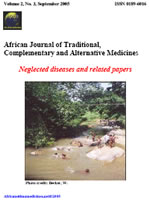
|
African Journal of Traditional, Complementary and Alternative Medicines
African Ethnomedicines Network
ISSN: 0189-6016
Vol. 14, No. 1, 2017, pp. 62-72
|
 Bioline Code: tc17008
Bioline Code: tc17008
Full paper language: English
Document type: Research Article
Document available free of charge
|
|
|
African Journal of Traditional, Complementary and Alternative Medicines, Vol. 14, No. 1, 2017, pp. 62-72
| en |
EVALUATION OF EFFECTIVENESS IN A NOVEL WOUND HEALING OINTMENT-CROCODILE OIL BURN OINTMENT
Li, Hua-Liang; Deng, Yi-Tao; Zhang, Zi-Ran; Fu, Qi-Rui; Zheng, Ya-Hui; Cao, Xing-Mei; Nie, Jing; Fu, Li-Wen; Chen, Li-Ping; Xiong, You-Xiong; Shen, Dong-Yan & Chen, Qing-Xi
Abstract
Background: Crocodile oil and its products are used as ointments for burns and scalds in traditional medicines. A new
ointment formulation - crocodile oil burn ointment (COBO) was developed to provide more efficient wound healing
activity. The purpose of the study was to evaluate the burn healing efficacy of this new formulation by employing deep
second-degree burns in a Wistar rat model. The analgesic and anti-inflammatory activities of COBO were also studied
to provide some evidences for its further use.
Materials and methods: The wound healing potential of this formulation was evaluated by employing a deep
second-degree burn rat model and the efficiency was comparatively assessed against a reference ointment – (1% wt ⁄ wt)
silver sulfadiazine (SSD). After 28 days, the animals were euthanized and the wounds were removed for transversal
and longitudinal histological studies. Acetic acid-induced writhing in mice was used to evaluate the analgesic activity
and its anti-inflammatory activity was observed in xylene -induced edema in mice.
Results: COBO enhanced the burn wound healing (20.5±1.3 d) as indicated by significant decrease in wound closure
time compared with the burn control (25.0±2.16 d) (P<0.01). Hair follicles played an importance role in the
physiological functions of the skin, and their growth in the wound could be revealed for the skin regeneration situation.
Histological results showed that the hair follicles were well-distributed in the post-burn skin of COBO treatment group,
and the amounts of total, active, primary and secondary hair follicles in post-burn 28-day skin of COBO treatment
groups were more than those in burn control and SSD groups. On the other hand, the analgesic and anti-inflammatory
activity of COBO were much better than those of control group, while they were very close to those of moist exposed
burn ointment (MEBO).
Conclusions: COBO accelerated wound closure, reduced inflammation, and had analgesic effects compared with SSD
in deep second degree rat burn model. These findings suggest that COBO would be a potential therapy for treating
human burns.
Keywords
Crocodile oil burn ointment; Chinese herbal medicine; Burn healing; Hair follicles; Antinociceptive; Anti-inflammatory
|
| |
© Copyright [2017] - African Journal of Traditional, Complementary and Alternative Medicines
Alternative site location: http://journals.sfu.ca/africanem/index.php/ajtcam
|
|
